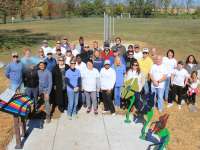“I’ve never encountered a project like this. The idea of exercise entering into urban design, much less public art, is pretty rare.”
- Thomas Sayre, Sculptor and Designer of Art Installation
From initial conversations, Main Terrain Art Park grew into more than just an art park and a solution to runoff water or the revitalization of an abandoned brownfield. The collaborative project brought together several government, public art and philanthropic organizations, as well as local businesses over the course of three years of development through fruition.
The City of Chattanooga explored various options of how to best manage the 1.72 acre brownfield located in the Southside of town. The City, ArtsBuild, and Public Art Chattanooga were looking for an avenue through which to cultivate public art on West Main Street and serve as an innovative representation of historical inspiration and contemporary design. Main Terrain Art Park was created with a vision that public art with a fitness focus would connect neighborhoods, people, and offer new experiences to the citizens in the community.
The city’s proposal described the concept of “placemaking.” This meant building a space where public art was one of many infused elements, but providing opportunities for physical activity was equally important as the visually compelling art to be featured. Rodney Van Valkenburg, Director of Grants and Initiatives at Allied Arts shared, “The idea of placemaking is how you can transform a barren, forgotten area and place something in that area that will be an attraction.”

Ross Fowler Landscape Architecture was selected to bring the City’s vision to life. However, in order to make it a functional place for citizens to effectively utilize, a stormwater management plan was needed to combat the ongoing challenge of pollution and overflow. The large lawn areas of the park are designed as stormwater infiltration basins in which up to 1.5 million gallons of water are diverted annually from being funneled into the city’s sewer system. Rain that falls on the park is directed to the infiltration basins which have under drain systems connected to the city’s harvested rainwater system. In turn, up to 40,000 gallons of harvested rainwater is filtered, treated, and then used to irrigate the landscape.
With initial groundbreaking in October of 2012, artist Thomas Sayre and his team of designers and architects assembled a nine-part interactive sculpture over the course of three months. His inspiration was the Walnut Street Bridge; the city’s historical walking bridge which connects the Northshore with the
Downtown Art District. The familiar local landmark serves as a symbolic demonstration of the city’s overall revitalization over the past decade.
 The art includes a unique fitness element with concrete pylons that are each topped with a moveable steel truss designed to spin around to create a physical bridge structure, resembling the local landmark. The park includes a running track looping the interior, open lawn areas, sustainable plantings, seating, bike racks, five fitness stations along the pathway, and a stormwater management system administered by the city’s land development office.
The art includes a unique fitness element with concrete pylons that are each topped with a moveable steel truss designed to spin around to create a physical bridge structure, resembling the local landmark. The park includes a running track looping the interior, open lawn areas, sustainable plantings, seating, bike racks, five fitness stations along the pathway, and a stormwater management system administered by the city’s land development office.



